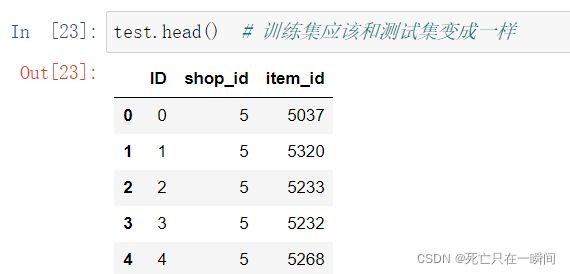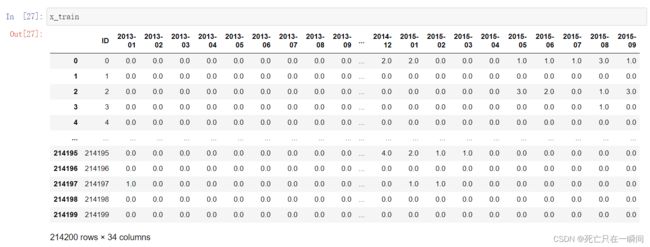【快乐Kaggle入门】Kaggle入门之比赛基本流程
目录
1.数据读取
2.数据清洗
3.数据重构
4.建模预测提交
5.总结
比赛的基本流程由四个部分组成:
数据读取、数据清洗、数据重构、建模预测提交
导包:
import numpy as np
import pandas as pd
import pandas_profiling as ppf
import joblib # 模型的保存
import matplotlib.pyplot as plt
import seaborn as sns
import warnings
warnings.filterwarnings("ignore") # 关闭警告模块1.数据读取
train = pd.read_csv("competitive-data-science-predict-future-sales/sales_train.csv") # 训练集
test = pd.read_csv("competitive-data-science-predict-future-sales/test.csv") # 测试集
shops = pd.read_csv("competitive-data-science-predict-future-sales/shops.csv") # 商品集
items = pd.read_csv("competitive-data-science-predict-future-sales/items.csv")
items_categories = pd.read_csv("competitive-data-science-predict-future-sales/item_categories.csv")
print("-" * 50)
print(train.head())
print("-" * 50)
print(test.head())
print("-" * 50)
print(shops.head())
print("-" * 50)
print(items.head())
print("-" * 50)
print(items_categories.head())
print("-" * 50)
# 检查维度
print("Shape of train:", train.shape)
print("Shape of test:", test.shape)
print("Shape of shops:", shops.shape)
print("Shape of items:", items.shape)
print("Shape of items_categories:", items_categories.shape)2.数据清洗
数据清洗的一般流程主要有两个操作:一是删除异常值,二是填补缺失值。【下面的代码是删除异常值】
# 先对每日销售的产品数量进行修改
train = train[train.item_cnt_day < 1001]
train = train[train.item_cnt_day > 0]
# 再对产品的销售价格进行修改
train = train[train.item_price < 250000]
train = train[train.item_price > 1]3.数据重构
先把训练数据的date列改为标准的格式:
train["date"] = pd.to_datetime(train["date"], format="%d.%m.%Y")将数据转换为月度销售数据:
%%time
# 制作仅包含月度销售数据的数据集 [分组]
data = train.groupby([train["date"].apply(lambda x:x.strftime("%Y-%m")),"item_id","shop_id"]).sum().reset_index()
# 指定我们要添加到的数据的重要属性
data = data[["date", "item_id", "shop_id", "item_cnt_day"]]
# 最后,我们可以从数据集中选择重要的特定属性
data = data.pivot_table(index=["item_id", "shop_id"], columns="date", values="item_cnt_day", fill_value=0).reset_index()
print(data.shape)
print(data.head())
print("-" * 50)
print(data.head())
print("-" * 50)
print(data)
# 目的是把每一个月的数据放到一起训练集应该和测试集变成相同的格式:
未处理前的测试数据:
处理后的测试数据:
# 将数据进行组合
test = pd.merge(test, data, on = ["item_id", "shop_id"], how = "left")
# 将空值填充为0
test.fillna(0, inplace=True)
# 看一下这个数据集
test.head()接下来创建实际的训练集:
# 现在创建实际的训练集
x_train = test.drop(["2015-10", "item_id", "shop_id"], axis = 1) # 和提交格式有关
y_train = test["2015-10"]
# 删除第一列,以便于预测未来的销售数据
x_test = test.drop(["2013-01", "item_id", "shop_id"], axis = 1) # 保持和训练集一样特征数
# 检查一下数据的维度
print("Shape of x_train:", x_train.shape)
print("Shape of x_test:", x_test.shape)
print("Shape of y_train:", y_train.shape)看一下训练数据的特征值:
看一下训练数据的目标值:
看一下测试集的特征值:
4.建模预测提交
先进行模型的构建,训练后保存模型为GBR2.pkl。
%%time
# 用GradientBoostingRegressor进行预测
from sklearn.ensemble import GradientBoostingRegressor
GBR = GradientBoostingRegressor()
GBR.fit(x_train, y_train)
mode2 = GBR.predict(x_test).clip(0,20) # 把预测结果限制在0到20之间
joblib.dump(GBR, "GBR2.pkl") # 模型保存取出预测值“item_cnt_month”,
mode2 = pd.DataFrame(mode2, columns=["item_cnt_month"])把预测结果存为submission.csv文件,这个文件就是需要提交到官网的文件。
mode2.to_csv("submission.csv", index_label="ID")看一下需要提交的数据:
5.总结
以上的四个部分是比赛的基本流程,可以提交获取一个基本的排名,若要再提升成绩,需要在特征工程和数据增强方面再做努力。





